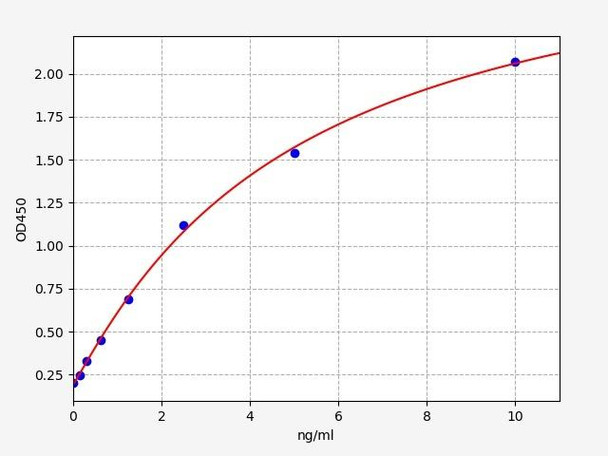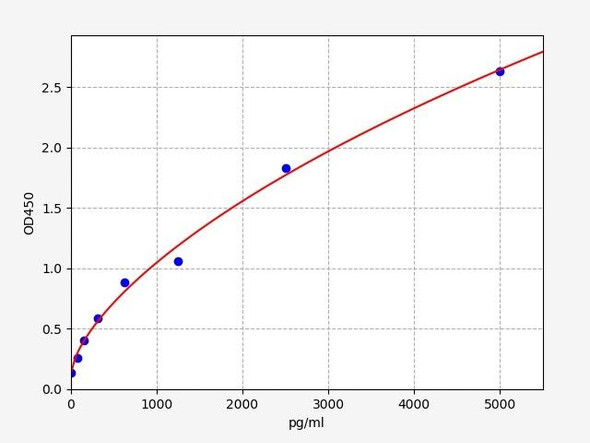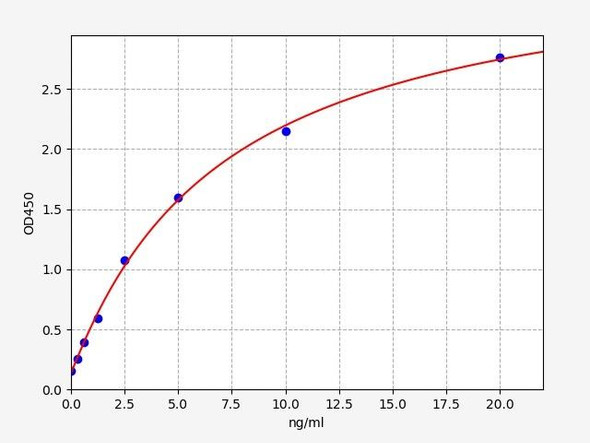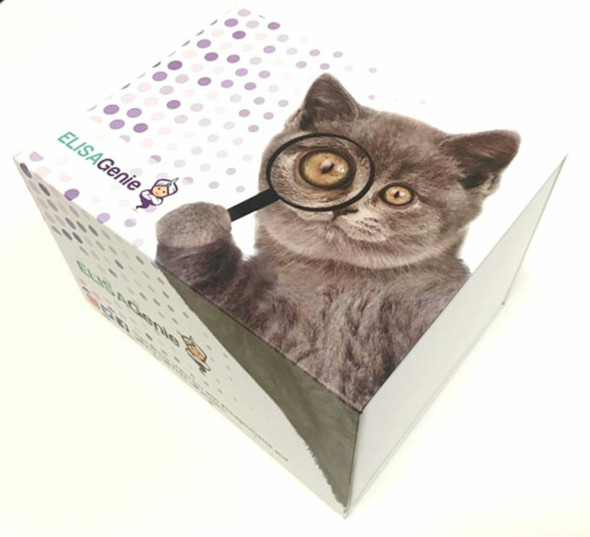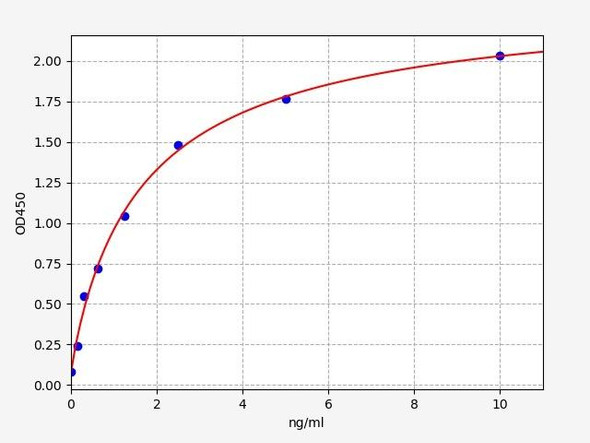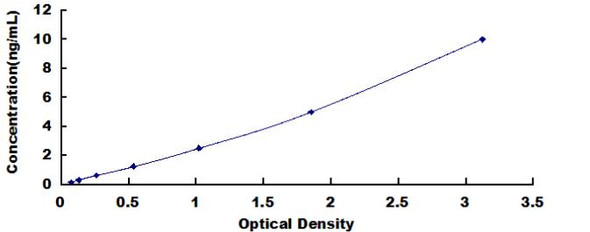Human DNM1L (Dynamin-1-like protein) ELISA Kit (HUFI05290)
- SKU:
- HUFI05290
- Product Type:
- ELISA Kit
- Size:
- 96 Assays
- Uniprot:
- O00429
- Sensitivity:
- 0.094ng/ml
- Range:
- 0.156-10ng/ml
- ELISA Type:
- Sandwich
- Synonyms:
- Dynamin-1-like protein, Dnm1p/Vps1p-like protein, DVLP, Dynamin family member proline-rich carboxyl-terminal domain less, Dymple, Dynamin-like protein, Dynamin-like protein 4, Dynamin-like protein IV, HdynIV, Dynamin-related protein 1, DNM1L, DLP1, D
- Reactivity:
- Human
Description
Human DNM1L (Dynamin-1-like protein) ELISA Kit (HUFI05290)
The Human DNM1L (Dynamin 1-like Protein) ELISA Kit is specifically designed for the precise detection of DNM1L levels in human samples, including serum, plasma, and cell culture supernatants. This kit offers exceptional sensitivity and specificity, ensuring accurate and consistent results for various research applications.DNM1L, also known as dynamin-related protein 1, is a key regulator of mitochondrial fission and fusion processes. Dysregulation of DNM1L has been linked to various diseases, including neurodegenerative disorders, cardiovascular diseases, and cancer.
Therefore, detecting and quantifying DNM1L levels can provide valuable insights for studying these conditions and developing potential therapeutic strategies.Overall, the Human DNM1L ELISA Kit is a valuable tool for researchers aiming to investigate the role of DNM1L in disease pathogenesis and progression. Its high performance and reliability make it an essential resource for advancing research in the field of mitochondrial dynamics and associated disorders.
| Product Name: | Human DNM1L (Dynamin-1-like protein) ELISA Kit |
| Product Code: | HUFI05290 |
| Size: | 96 Assays |
| Alias: | Dynamin-1-like protein ELISA Kit, Dnm1p/Vps1p-like protein ELISA Kit, DVLP ELISA Kit, Dynamin family member proline-rich carboxyl-terminal domain less ELISA Kit, Dymple ELISA Kit, Dynamin-like protein ELISA Kit, Dynamin-like protein 4 ELISA Kit, Dynamin-like protein IV ELISA Kit, HdynIV ELISA Kit, Dynamin-related protein 1 ELISA Kit, DNM1L ELISA Kit, DLP1 ELISA Kit, DRP1 ELISA Kit |
| Detection method: | Sandwich ELISA, Double Antibody |
| Application: | This immunoassay kit allows for the in vitro quantitative determination of Human DNM1L (Dynamin-1-like protein) concentrations in serum plasma and other biological fluids. |
| Sensitivity: | < 0.094ng/ml |
| Range: | 0.156-10ng/ml |
| Storage: | 4°C for 6 months |
| Note: | For Research Use Only |
| Recovery: | Matrices listed below were spiked with certain level of Human DNM1L (Dynamin-1-like protein) and the recovery rates were calculated by comparing the measured value to the expected amount of Human DNM1L (Dynamin-1-like protein) in samples. | ||||||||||||||||
| |||||||||||||||||
| Linearity: | The linearity of the kit was assayed by testing samples spiked with appropriate concentration of Human DNM1L (Dynamin-1-like protein) and their serial dilutions. The results were demonstrated by the percentage of calculated concentration to the expected. | ||||||||||||||||
| |||||||||||||||||
| CV(%): | Intra-Assay: CV<8% Inter-Assay: CV<10% |
| Component | Quantity | Storage |
| ELISA Microplate (Dismountable) | 8×12 strips | 4°C for 6 months |
| Lyophilized Standard | 2 | 4°C/-20°C |
| Sample/Standard Dilution Buffer | 20ml | 4°C |
| Biotin-labeled Antibody(Concentrated) | 120ul | 4°C (Protect from light) |
| Antibody Dilution Buffer | 10ml | 4°C |
| HRP-Streptavidin Conjugate(SABC) | 120ul | 4°C (Protect from light) |
| SABC Dilution Buffer | 10ml | 4°C |
| TMB Substrate | 10ml | 4°C (Protect from light) |
| Stop Solution | 10ml | 4°C |
| Wash Buffer(25X) | 30ml | 4°C |
| Plate Sealer | 5 | - |
Other materials and equipment required:
- Microplate reader with 450 nm wavelength filter
- Multichannel Pipette, Pipette, microcentrifuge tubes and disposable pipette tips
- Incubator
- Deionized or distilled water
- Absorbent paper
- Buffer resevoir
| UniProt Protein Function: | DRP1: Functions in mitochondrial and peroxisomal division. Mediates membrane fission through oligomerization into ring-like structures which wrap around the scission site to constict and sever the mitochondrial membrane through a GTP hydrolysis- dependent mechanism. Required for normal brain development. Facilitates developmentally-regulated apoptosis during neural tube development. Required for a normal rate of cytochrome c release and caspase activation during apoptosis. Also required for mitochondrial fission during mitosis. May be involved in vesicle transport. Homotetramer; dimerizes through the N-terminal GTP-middle region of one molecule binding to the GED domain of another DNM1L molecule. Can self-assemble in multimeric ring-like structures. Interacts with BCL2L1; the interaction stimulates the GTPase activity of DMN1L in synapses and increases the number of axonal mitochondria and the size and number of synaptic vesicle clusters. Interacts with FIS1. Interacts with GSK3B and MARCH5. Interacts (via the GTPase and B domains) with UBE2I; the interaction promotes sumoylation of DNM1L, mainly in ite B domain. Interacts with PPP3CA; the interaction dephosphorylates DNM1L and regulates its transition to mitochondria. Interacts witn MID49 and MID51. Ubiquitously expressed with highest levels found in skeletal muscles, heart, kidney and brain. Isoform 1 is brain-specific. Isoform 2 and isoform 3 are predominantly expressed in testis and skeletal muscles respectively. Isoform 4 is weakly expressed in brain, heart and kidney. Isoform 5 is dominantly expressed in liver, heart and kidney. Isoform 6 is expressed in neurons. Belongs to the dynamin family. 6 isoforms of the human protein are produced by alternative splicing. |
| UniProt Protein Details: | Protein type:Endoplasmic reticulum; Mitochondrial; Microtubule-binding; EC 3.6.5.5; Apoptosis; Hydrolase; Motor Chromosomal Location of Human Ortholog: 12p11.21 Cellular Component: Golgi apparatus; microtubule; protein complex; intracellular membrane-bound organelle; synaptic vesicle membrane; mitochondrion; coated pit; cytosol; mitochondrial outer membrane; membrane; perinuclear region of cytoplasm; cytoplasm; peroxisome; cell junction Molecular Function:GTPase activity; identical protein binding; protein binding; protein homodimerization activity; GTP binding; ubiquitin protein ligase binding; lipid binding Biological Process: peroxisome fission; mitochondrial fission; release of cytochrome c from mitochondria; positive regulation of protein secretion; positive regulation of apoptosis; apoptosis; metabolic process; regulation of protein oligomerization; endocytosis; mitochondrial fragmentation during apoptosis; cell structure disassembly during apoptosis; protein homotetramerization Disease: Encephalopathy, Lethal, Due To Defective Mitochondrial And Peroxisomal Fission |
| NCBI Summary: | This gene encodes a member of the dynamin superfamily of GTPases. The encoded protein mediates mitochondrial and peroxisomal division, and is involved in developmentally regulated apoptosis and programmed necrosis. Dysfunction of this gene is implicated in several neurological disorders, including Alzheimer's disease. Mutations in this gene are associated with the autosomal dominant disorder, encephalopathy, lethal, due to defective mitochondrial and peroxisomal fission (EMPF). Alternative splicing results in multiple transcript variants encoding different isoforms. [provided by RefSeq, Jun 2013] |
| UniProt Code: | O00429 |
| NCBI GenInfo Identifier: | 125987821 |
| NCBI Gene ID: | 10059 |
| NCBI Accession: | O00429.2 |
| UniProt Secondary Accession: | O00429,O14541, O60709, Q59GN9, Q7L6B3, Q8TBT7, Q9BWM1 Q9Y5J2, A8K4X9, B4DGC9, B4DSU8, J3KPI2, |
| UniProt Related Accession: | O00429 |
| Molecular Weight: | 736 |
| NCBI Full Name: | Dynamin-1-like protein |
| NCBI Synonym Full Names: | dynamin 1-like |
| NCBI Official Symbol: | DNM1L |
| NCBI Official Synonym Symbols: | DLP1; DRP1; DVLP; EMPF; DYMPLE; HDYNIV |
| NCBI Protein Information: | dynamin-1-like protein; dynamin-like protein 4; dynamin-like protein IV; Dnm1p/Vps1p-like protein; dynamin-related protein 1; dynamin family member proline-rich carboxyl-terminal domain less |
| UniProt Protein Name: | Dynamin-1-like protein |
| UniProt Synonym Protein Names: | Dnm1p/Vps1p-like protein; DVLP; Dynamin family member proline-rich carboxyl-terminal domain less; Dymple; Dynamin-like protein; Dynamin-like protein 4; Dynamin-like protein IV; HdynIV; Dynamin-related protein 1 |
| Protein Family: | Dynamin-1-like protein |
| UniProt Gene Name: | DNM1L |
| UniProt Entry Name: | DNM1L_HUMAN |
*Note: Protocols are specific to each batch/lot. For the correct instructions please follow the protocol included in your kit.
Before adding to wells, equilibrate the SABC working solution and TMB substrate for at least 30 min at 37 °C. When diluting samples and reagents, they must be mixed completely and evenly. It is recommended to plot a standard curve for each test.
| Step | Protocol |
| 1. | Set standard, test sample and control (zero) wells on the pre-coated plate respectively, and then, record their positions. It is recommended to measure each standard and sample in duplicate. Wash plate 2 times before adding standard, sample and control (zero) wells! |
| 2. | Aliquot 0.1ml standard solutions into the standard wells. |
| 3. | Add 0.1 ml of Sample / Standard dilution buffer into the control (zero) well. |
| 4. | Add 0.1 ml of properly diluted sample ( Human serum, plasma, tissue homogenates and other biological fluids.) into test sample wells. |
| 5. | Seal the plate with a cover and incubate at 37 °C for 90 min. |
| 6. | Remove the cover and discard the plate content, clap the plate on the absorbent filter papers or other absorbent material. Do NOT let the wells completely dry at any time. Wash plate X2. |
| 7. | Add 0.1 ml of Biotin- detection antibody working solution into the above wells (standard, test sample & zero wells). Add the solution at the bottom of each well without touching the side wall. |
| 8. | Seal the plate with a cover and incubate at 37 °C for 60 min. |
| 9. | Remove the cover, and wash plate 3 times with Wash buffer. Let wash buffer rest in wells for 1 min between each wash. |
| 10. | Add 0.1 ml of SABC working solution into each well, cover the plate and incubate at 37 °C for 30 min. |
| 11. | Remove the cover and wash plate 5 times with Wash buffer, and each time let the wash buffer stay in the wells for 1-2 min. |
| 12. | Add 90 µL of TMB substrate into each well, cover the plate and incubate at 37 °C in dark within 10-20 min. (Note: This incubation time is for reference use only, the optimal time should be determined by end user.) And the shades of blue can be seen in the first 3-4 wells (with most concentrated standard solutions), the other wells show no obvious color. |
| 13. | Add 50 µL of Stop solution into each well and mix thoroughly. The color changes into yellow immediately. |
| 14. | Read the O.D. absorbance at 450 nm in a microplate reader immediately after adding the stop solution. |
When carrying out an ELISA assay it is important to prepare your samples in order to achieve the best possible results. Below we have a list of procedures for the preparation of samples for different sample types.
| Sample Type | Protocol |
| Serum | If using serum separator tubes, allow samples to clot for 30 minutes at room temperature. Centrifuge for 10 minutes at 1,000x g. Collect the serum fraction and assay promptly or aliquot and store the samples at -80°C. Avoid multiple freeze-thaw cycles. If serum separator tubes are not being used, allow samples to clot overnight at 2-8°C. Centrifuge for 10 minutes at 1,000x g. Remove serum and assay promptly or aliquot and store the samples at -80°C. Avoid multiple freeze-thaw cycles. |
| Plasma | Collect plasma using EDTA or heparin as an anticoagulant. Centrifuge samples at 4°C for 15 mins at 1000 × g within 30 mins of collection. Collect the plasma fraction and assay promptly or aliquot and store the samples at -80°C. Avoid multiple freeze-thaw cycles. Note: Over haemolysed samples are not suitable for use with this kit. |
| Urine & Cerebrospinal Fluid | Collect the urine (mid-stream) in a sterile container, centrifuge for 20 mins at 2000-3000 rpm. Remove supernatant and assay immediately. If any precipitation is detected, repeat the centrifugation step. A similar protocol can be used for cerebrospinal fluid. |
| Cell culture supernatant | Collect the cell culture media by pipette, followed by centrifugation at 4°C for 20 mins at 1500 rpm. Collect the clear supernatant and assay immediately. |
| Cell lysates | Solubilize cells in lysis buffer and allow to sit on ice for 30 minutes. Centrifuge tubes at 14,000 x g for 5 minutes to remove insoluble material. Aliquot the supernatant into a new tube and discard the remaining whole cell extract. Quantify total protein concentration using a total protein assay. Assay immediately or aliquot and store at ≤ -20 °C. |
| Tissue homogenates | The preparation of tissue homogenates will vary depending upon tissue type. Rinse tissue with 1X PBS to remove excess blood & homogenize in 20ml of 1X PBS (including protease inhibitors) and store overnight at ≤ -20°C. Two freeze-thaw cycles are required to break the cell membranes. To further disrupt the cell membranes you can sonicate the samples. Centrifuge homogenates for 5 mins at 5000xg. Remove the supernatant and assay immediately or aliquot and store at -20°C or -80°C. |
| Tissue lysates | Rinse tissue with PBS, cut into 1-2 mm pieces, and homogenize with a tissue homogenizer in PBS. Add an equal volume of RIPA buffer containing protease inhibitors and lyse tissues at room temperature for 30 minutes with gentle agitation. Centrifuge to remove debris. Quantify total protein concentration using a total protein assay. Assay immediately or aliquot and store at ≤ -20 °C. |
| Breast Milk | Collect milk samples and centrifuge at 10,000 x g for 60 min at 4°C. Aliquot the supernatant and assay. For long term use, store samples at -80°C. Minimize freeze/thaw cycles. |

